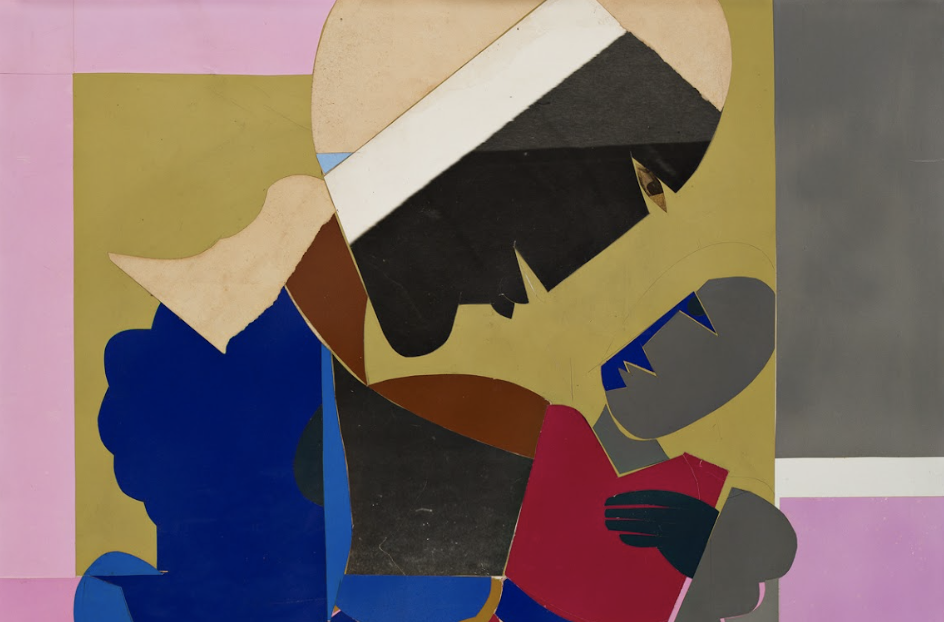Overview
Students will explore tearing paper to make a variety of basic shapes with different kinds of edges. They will experiment with several arrangements before gluing down their shapes.
Materials and Tools
- Pencil
- Sketchbook or one to two pieces of paper
- Collage from the previous lesson
Activities
Note: The following activities are written with sample language you may use with your students. Following the art-making lesson, you may choose as many reflection activities as desired for students to work on in class or independently.
Step 1: Close-Looking Activity/Sharing Student Work (10 minutes)
Hello, artists! Today we are going to continue exploring the new shapes that we made by cutting. Take a close look at your collage.

- What new shapes did you make using scissors?
- Did you like cutting shapes more than tearing? Why?
Have students share several new shapes and opinions about cutting versus tearing.
Step 2: Writing Activity (10 minutes)
Now we are going to write about our artwork. Choose two of your favorite shapes in your collage.
- How are they different?
- How are they the same?
Based on your students’ writing skills, choose from the options below:
Option 1: Write two sentences about your shapes to tell us one thing that’s the same about them and one thing that is different.
Option 2: Use the sentence frames below to write a sentence about your artwork.
- Both shapes are __________.
- One shape is __________ but the other is ________.
small
large
round
organic
geometric
smooth
bumpy
curvy
zigzag
circle
square
rectangle
triangle
Option 3: Label your collage using the vocabulary words above.
Step 3: Sketchbook Activity (10-15 minutes)
Now that you have looked closely at these new shapes in your collage, we’re going to transform your favorite one into something new from your imagination.
Look closely at your collage from Lesson 3. Choose one shape from your collage that you like. Draw it in your sketchbook.
Now, think about what it reminds you of. Could it be part of an animal? A car? A kind of food?
- What details can you add to change it into a new thing?
Add details to your shape to change it into something new.
Model drawing your favorite shape. Choose a unique shape to draw that students may not have on their papers, so they will come up with their own ideas. Ask: What does this shape remind you of? What could I add to make it into that idea?
Take suggestions from students and add a few details to your drawing.
Now it’s your turn.
- What shape will you choose?
- How will you add to your shape to change it?
After students finish their drawings, ask:
- What did your shape remind you of?
- What shapes, lines, or details did you add to show your idea?
Step 4: Close Looking: Romare Bearden (10-15 minutes)
Note to Teachers: Before teaching with a work of art, spend some time looking closely at it on your own. Familiarizing yourself with the artwork will prepare you to guide the close-looking activity.
If your students are new to looking at art together, you can introduce the activity to students in the following way:
Today we are going to spend some time looking at and discussing a work of art together. When we look at art, there are no right or wrong answers. I’m going to ask you to look closely, share your ideas about what you see, and listen respectfully to each other’s ideas. Everyone’s ideas are important. We all see things differently, and when we look at art, we can learn to see through each other’s eyes.

Let’s look closely at this collage by the artist Romare Bearden.
- What do you notice about this artwork?
- What kinds of shapes do you notice? What organic shapes do you notice? What geometric shapes?
- Do you notice any places where the artist overlapped their shapes?
For students needing more support:
- I notice _________.
- I see _________ shapes.
- The artist overlapped the _________ and ___________ shapes.
Resources


Collage lesson on shapes from The National Gallery of Art, Washington, D.C.

